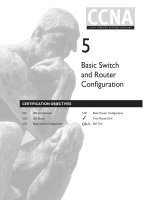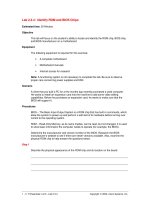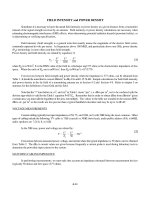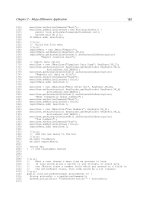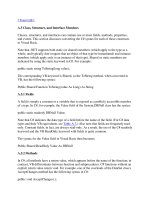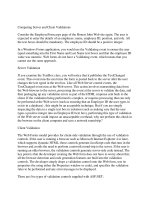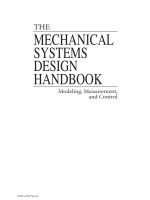Tài liệu Consumer behaviour and advertising managerment doc
Bạn đang xem bản rút gọn của tài liệu. Xem và tải ngay bản đầy đủ của tài liệu tại đây (4.29 MB, 391 trang )
This page
intentionally left
blank
Copyright © 2006, New Age International (P) Ltd., Publishers
Published by New Age International (P) Ltd., Publishers
All rights reserved.
No part of this ebook may be reproduced in any form, by photostat, microfilm,
xerography, or any other means, or incorporated into any information retrieval
system, electronic or mechanical, without the written permission of the publisher.
All inquiries should be emailed to
P
UBLISHING
FOR
ONE
WORLD
NEW AGE INTERNATIONAL (P) LIMITED, PUBLISHERS
4835/24, Ansari Road, Daryaganj, New Delhi - 110002
Visit us at www.newagepublishers.com
ISBN (13) : 978-81-224-2552-9
Preface
The book Consumer Behaviour and Advertising Management has been written for the
management students of Indian institutions. It clearly explains the fundamentals of the subject
and is designed to give an insight to the students with Indian examples. The book is written in
simple language so that it can be understood by the students and teachers.
Almost all the topics on consumer behaviour and advertising have been covered in this
book. The entire syllabi of the I.E.T. has been covered and the book will be useful for the
students. All the factors effecting consumer behaviour and some cases have been dealt in the
book. In advertising, besides the promotional tools, five 5 Ms of advertising, ethical and social
issues have also been dealt in a comprehensive manner. Both the sections of the book are
supplemented with brief examples of cases for the understanding of the students.
—Matin Khan
This page
intentionally left
blank
Acknowledgement
This book could not have been written without the motivation and guidance of the publishers
of New Age International (P) Ltd. They invited me to write a book on Consumer Behaviour and
Advertising exclusively for the I.E.T. students. They guided me to cover all the aspects given
in the course outline.
My students, earlier, had appreciated and liked my book Consumer Behaviour which
was written in simple language. I am thankful to the students who have been under me from
a number of institutions. I would like to thank Mr. L.N. Mishra of Lucknow branch of New Age
International (P) Ltd. who has been a source of inspiration. I want to acknowledge the help I
received from my family members, and would like to thank my wife Shamin Khan, my daugh-
ters Maria and Sara and my son Ishrat who gave me time and discussed various issues with
me. In would like to thank Prof. and Head of Deptt. Prof. J.K. Sharma, Dr. S. Medhabi, Dr. Rita
Narang and my other colleagues and students whom I have been associated with. Thanks are
also due to others who have helped me in bringing out this book.
—Matin Khan
This page
intentionally left
blank
Contents
Preface v
Acknowledgements vii
PART I: Consumer Behaviour
1 Consumer Behaviour 3
1.1 Introduction to Consumer Behaviour—Definition 4
1.2 Reasons for Studying Consumer Behaviour 5
1.3 Applying Consumer Behaviour Knowledge 6
1.4 Marketing Strategy and Consumer Behaviour 8
1.5 Market Analysis 9
Questions 12
1.6 Consumer Behaviour and Market Segment 13
1.7 Bases for Segmentation 14
2 Psychographic or Lifestyle Segmentation 17
2.1 Introduction 18
Questions 23
3 Environmental Influences 25
3.1 Introduction 26
3.2 Individual Determinants 27
3.3 External Environmental Factors Affecting Consumer Behaviour 29
Questions 31
4Concept of Culture and Subculture 33
4.1 Introduction 34
Questions 40
DHARM
N-ADVER\TITLE.PM5
( x )
5 Cultural Variations in Non-Verbal Communications 41
5.1 Introduction 42
Questions 47
6 Social Class 49
6.1 What is a Social Class 50
Questions 55
7 Social Group 57
7.1 Introduction 58
7.2 Reference Groups and the Influence Exerted by them 60
7.3 Reference Group, Social Influence and Social Power 61
7.4 Reference Group Applications in Marketing 63
Questions 66
8 Family Buying Influences, Family Life Cycle and Buying Roles 67
8.1 Introduction 68
8.2 Family Buying Influences 70
8.3 The Family Life Cycle Stages 72
8.4 Personal Influences 74
Questions 76
9 Diffusion of Innovation 77
9.1 Introduction 78
9.2 Innovation 78
9.3 Diffusion Process 80
Questions 85
10 Individual Determinants 87
10.1 Perception 88
10.2 Misinterpretation of Marketing Messages 91
11 Personality and Self Concept 93
11.1 Personality 94
11.2 Types of Behaviour 97
11.3 Emotions and Marketing Strategy 99
11.4 Self-concept 99
Questions 101
12 Motivation and Involvement 103
12.1 Introduction 104
DHARM
N-ADVER\TITLE.PM5
( xi )
12.2 Maslow’s Theory of Motivation 104
12.3 Marketing Strategies Based on Motivation 107
12.4 Involvement 108
Questions 110
13 Information Processing Learning and Memory 111
13.1 Introduction 112
13.2 Learning Memory and Product Positioning 114
13.3 Memory 116
Questions 118
14Attitude Development and Alternate Evaluation in Buying 119
14.1 Introduction 120
14.2 Heuristics (The Choice-making Rules) 122
14.3 Multi-Attribute Choice Models 124
Questions 128
15 Decision-Making Process 129
15.1 Problem Recognition and Purchase Behaviour 131
Questions 137
16 Search and Evaluation 139
16.1 Introduction 140
Questions 147
17 Purchasing Process and Outlet Selection 149
17.1 Introduction 150
Questions 157
18 Purchase Behaviour (Situational Factors) 159
18.1 Introduction 160
Questions 165
19 Post-Purchase Behaviour 167
19.1 Introduction 168
Questions 171
20 Models of Consumer Behaviour 173
20.1 Introduction 174
Questions 187
DHARM
N-ADVER\TITLE.PM5
( xii )
21 Consumerism (Public Policy and Consumer Protection) 189
21.1 Introduction 191
Questions 196
22 Organisational Buying Behaviour 197
22.1 Introduction 198
22.2 Characteristics of ORG Buying (O.B.B.) 199
22.3 Organisational Customers 201
22.4 Factors Influencing Organisational Buying 202
22.5 Factors that Affect Risk 203
22.6 Organisational Buying Situations 204
Questions 206
23 Customer Delight 207
23.1 Introduction 208
23.2 Need for Delight 209
23.3 Expectation and Delight 210
23.4 Generating Delight 211
Questions 212
24E-Consumer Behaviour 213
24.1 The Computer Age 214
24.2 E-Business 214
24.3 Web (World Wide Web) WWW 216
24.4 Application to Customer Behaviour 216
Questions 218
25 Consumer Research 219
25.1 Introduction 220
25.2 The Objectives of the Study 221
25.3 Secondary Data 221
25.4 Primary Data 223
25.5 Purchase Behaviour 223
25.6 Semantic Differential Scale 225
25.7 Observation, Experimentation, Survey and Interviews 227
25.8 Data Analysis 229
Questions 230
26 Changing Consumer Behaviour 231
26.1 In the Indian Context 232
Questions 234
DHARM
N-ADVER\TITLE.PM5
( xiii )
27 Case Studies 235
27.1 Case I: Factors Affecting Consumer Behaviour 236
Questions 236
27.2 Case II: Organisational Buying Behaviour 236
Questions 237
27.3 Case III: Family Influences 237
Questions 237
27.4 Case IV: Health Conscious Consumer 238
Questions 238
27.5 Case V: A.T.O. Model of Consumer Behaviour 239
Questions 239
27.6 Case VI: Vending Machines (Motivation) 240
Questions 240
27.7 Case VII: Buyer’s Behaviour 240
Questions 241
27.8 Case VIII: Promoting Beauty Products (Marketing Strategy) 241
Questions 242
27.9 Case IX: Organisation Buying 242
Questions 243
PART II: Advertising Management
1 Advertising Management Overview 247
1.1 Meaning 248
1.2 Nature of Advertising 248
1.3 Scope of Advertising 249
1.4 Types of Advertising 252
Questions 257
2 Advertising and Other Promotional Tools 259
2.1 Meaning 260
2.2 Publicity 263
Questions 264
3 Role of Advertising in Promotion Mix 265
Questions 267
4Process of Advertising 269
4.1 Introduction 270
4.2 The Customer and Competition 276
DHARM
N-ADVER\TITLE.PM5
( xiv )
4.3 Competitive Analysis 278
Questions 279
5 Strategies for Advertising 281
5.1 Introduction 282
5.2 Strategies for Advertising 284
5.3 Advertising Planning 285
6 Advertising Campaign Planning 287
Questions 290
7 Message Creation and Copywriting 291
Questions 302
8 Role of Creativity in Copywriting 303
Questions 309
9 Advertising Objectives (Mission) 311
Questions 315
10 Media Planning 317
Questions 325
11 Testing for Advertising Effectiveness 327
11.1 Source 328
11.2 Message 328
11.3 Media Strategies 328
11.4 Budget 329
11.5 Physiological Tests 330
Questions 334
12 Preparation and Choice of Methods of Advertising Budget 335
12.1 Budgeting Methods 336
12.2 Budgeting Approaches 337
12.3 Other Factors Affecting the Allocation of Advertising Budget 340
Questions 341
13 Ethical and Social Issues in Advertising 343
13.1 Ethical Advertising 344
13.2 Social Issues in Advertising 345
DHARM
N-ADVER\TITLE.PM5
( xv )
14Management of Advertising Agency 349
14.1 Function of an Advertising Agency 351
14.2 Types of Agencies 352
Questions 355
15 Role of Advertising in National Development 357
15.1 General Advertising 358
15.2 Cases and Institutional Advertising 361
Questions 362
Index 369
This page
intentionally left
blank
PART IPART I
Consumer Behaviour
This page
intentionally left
blank
Consumer Behaviour
This chapter provides an introduction to consumer behaviour. “Consumer is the mostThis chapter provides an introduction to consumer behaviour. “Consumer is the most
This chapter provides an introduction to consumer behaviour. “Consumer is the mostThis chapter provides an introduction to consumer behaviour. “Consumer is the most
This chapter provides an introduction to consumer behaviour. “Consumer is the most
important person. The business revolves around the consumer.”important person. The business revolves around the consumer.”
important person. The business revolves around the consumer.”important person. The business revolves around the consumer.”
important person. The business revolves around the consumer.”
After finishing this chapter, one should be able to understand:After finishing this chapter, one should be able to understand:
After finishing this chapter, one should be able to understand:After finishing this chapter, one should be able to understand:
After finishing this chapter, one should be able to understand:
•
What is meant by consumer behaviourWhat is meant by consumer behaviour
What is meant by consumer behaviourWhat is meant by consumer behaviour
What is meant by consumer behaviour
•
Reasons for studying consumer behaviourReasons for studying consumer behaviour
Reasons for studying consumer behaviourReasons for studying consumer behaviour
Reasons for studying consumer behaviour
•
Understanding consumer behaviourUnderstanding consumer behaviour
Understanding consumer behaviourUnderstanding consumer behaviour
Understanding consumer behaviour
•
Marketing strategy and consumer behaviourMarketing strategy and consumer behaviour
Marketing strategy and consumer behaviourMarketing strategy and consumer behaviour
Marketing strategy and consumer behaviour
Customer is profit, all else is overload......
1
Consumer Behaviour
C
HAPTER
1
4
1.1 Introduction to Consumer BehaviourDefinition
All of us are consumers. We consume things of daily use, we also consume and buy these
products according to our needs, preferences and buying power. These can be consumable
goods, durable goods, speciality goods or, industrial goods.
What we buy, how we buy, where and when we buy, in how much quantity we buy
depends on our perception, self concept, social and cultural background and our age and family
cycle, our attitudes, beliefs, values, motivation, personality, social class and many other factors
that are both internal and external to us. While buying, we also consider whether to buy or not
to buy and, from which source or seller to buy. In some societies, there is a lot of affluence and,
these societies can afford to buy in greater quantities and at shorter intervals. In poor societies,
the consumer can barely meet his barest needs.
Consumer behaviour can be defined as the decision-making process and physical activ-
ity involved in acquiring, evaluating, using and disposing of goods and services.
This definition clearly brings out that it is not just the buying of goods/services that
receives attention in consumer behaviour but, the process starts much before the goods have
been acquired or bought. A process of buying starts in the minds of the consumer, which leads
to the finding of alternatives between products that can be acquired with their relative advan-
tages and disadvantages. This leads to internal and external research. Then follows a process
of decision-making for purchase and using the goods, and then the post-purchase behaviour
which is also very important, because it gives a clue to the marketeers whether his product has
been a success or not.
The marketeers therefore tries to understand the needs of different consumers and
having understood his different behaviours which require an in-depth study of their internal
and external environment, they formulate their plans for marketing.
Consumer generally refers to any one engaging in any one or all of the activities stated
in our definition. The traditional viewpoint was to define consumers strictly in terms of economic
goods and services and purchasers of products offered for sale. The view now has been broadened.
It now also holds that monetory change is not essential for the definition of consumers. Few
potential adopters of free services, or even philosophic ideas can be encompassed by this
definition.
CONSUMER BEHAVIOUR
5
DHARM
N-ADVER\AD1-1.PM5
Sometimes, the goods are bought by the father and the children use it. The children
ultimately become the consumer. A packet of coloured crayons bought by the father and used
by his children in school.
The father buys a refrigerator and the user is the entire household. Therefore, we study
certain consumer behaviour roles.
Table 1.1 Some consumer behaviour roles
Roles Descriptions
Initiator
The individual who determines that certain need or want is not being fulfilled and
purchases a product to fulfill the need.
Influencer
A person who by some intentional or unintentional word or action influences the
purchase decision.
Buyer
The individual who actually makes the purchase transaction mostly is the head of
the family.
User
The person or persons who consume or use the purchase product.
To understand the consumer, researches are made. Sometimes, motivational research
is handy to bring out hidden attitude, uncover emotions and feelings. Many firms send
questionnaire to customers to ask about their satisfaction, future needs and ideas for a new
product. On the basis of the answers received a change in the marketing mix is made and
advertising is also streamlined.
1.2 Reasons for Studying Consumer Behaviour
The most important reason for studying consumer behaviour is the role that it plays in our
lives. We spend a lot of time in shops and market places. We talk and discuss with friends
about products and services and get lot of information from T.V. This influences our daily
lives.
Consumer decisions are affected by their behaviour. Therefore, consumer behaviour is
said to be an applied discipline. This leads to the microperspective and societal perspective.
Micro Perspective. It involves understanding consumer for the purpose of helping a
firm or organization to achieve its objectives. All the Managers in different departments are
keen to understand the consumer.
They may be Advertising Managers, Product Designers, Marketing and Sales Manag-
ers and so on.
Societal Perspective is on the macro level. Consumers collectively influenced eco-
nomic and social conditions within a society. Consumers strongly influence what will be prod-
uct, what resources will be used and it affects our standard of living.
Management is the youngest of sciences and oldest of arts and consumer behaviour in
management is a very young discipline. Various scholars and academicians concentrated on it
at a much later stage. It was during the 1950s, that marketing concept developed, and thus the
need to study the behaviour of consumers was recognised. Marketing starts with the needs of
the customer and ends with his satisfaction. When everything revolves round the customer
DHARM
N-ADVER\AD1-1.PM5
6
CONSUMER BEHAVIOUR
then the study of consumer behaviour becomes a necessity. It starts with buying of goods. Goods
can be bought individually, or in groups. Goods can be bought under stress (to satisfy an
immediate need), for comfort and luxury in small quantities or in bulk. For all this, exchange
is required. This exchange is usually between the seller and the buyer. It can also be between
consumers.
To understand the likes and dislikes of the consumer, extensive consumer research
studies are being conducted. These researches try to find out:
• What the consumer thinks of the company’s products and those of its competitors?
• How can the product be improved in their opinion?
• How the customers use the product?
• What is the customer’s attitude towards the product and its advertising?
• What is the role of the customer in his family?
The following key questions should be answered for consumer research. A market comes
into existence because it fulfils the needs of the consumer. In this connection, a marketeer has
to know the 70s framework for consumer research. Taking from an example of soap.
Table 1.2
Who constitutes the market? Parent, child, male, female Occupants
What does the market buy? Soap, regular, medicated, with glycerine, Objects
Herbal what brand, what size
Who participates in buying? Parent, child, male, female Organisations
How does the market buy? Cash, credit, mail-order etc. Operations
When does the market buy? Monthly, weekly etc. prescribed by doctor Occasions
(medicinal)
Where does the market buy? Supermarket, retail store etc. Outlet
Why does the market buy? For cleansing, bathing, fresh feeling etc. Objectives
(taken from multi-marketeer)
Consumer behaviour is a complex, dynamic, multi-dimensional process, and all market-
ing decisions are based on assumptions about consumer behaviour.
Marketing strategy is the game plan which the firms must adhere to, in order to outdo
the competitor or the plans to achieve the desired objective. In formulating the marketing
strategy, to sell the product effectively, cost-benefit analysis must be undertaken.
1.3 Applying Consumer Behaviour Knowledge
(1) Consumer behaviour knowledge is applied in Marketing Management. A sound
understanding of the consumer behaviour is essential to the long-term success of
any marketing programme. It is the corner stone of marketing concept which stress
on consumer wants and needs, target market selection, integrated marketing and
profits through the satisfaction of the consumers.
(2) Consumer behaviour is also important in non-profit and social organizations. Such
organizations are govt. agencies, religious organizations, universities and charitable
organizations.
CONSUMER BEHAVIOUR
7
DHARM
N-ADVER\AD1-1.PM5
(3) Consumer behaviour is applied to improve the performance of government agencies
as well. For instance, the performance of government transportation is poor. It can
be improved by knowing the needs and wants of the consumers. Getting checks from
them for their likes or dislikes. Same can be applied to other organizations like
universities and charitable organizations.
(4) Consumer behaviour also helps in marketing of various goods which are in scarcity.
People are made aware that gas, fuel, water and natural resources are in scarcity.
Consumers are encouraged to reduce their consumption of these commodities.
(5) Consumer benefit from the investigation of their own behaviour. When the consumer
learns the many variables that affect his behaviour. He gets educated and under-
stands better how to effect his own behaviour. What is learnt about consumer behav-
iour also benefit consumer in a formal sense.
There can be many benefits of a product, for example, for owning a motor bike, one can
be looking for ease of transportation, status, pleasure, comfort and feeling of ownership. The
cost is the amount of money paid for the bike, the cost of maintenance, gasoline, parking, risk
of injury in case of an accident, pollution and frustration such as traffic jams. The difference
between this total benefit and total cost constitutes the customer value. The idea is to provide
superior customer value and this requires the formulation of a marketing strategy. The entire
process consists of market analysis, which leads to target market selection, and then to the
formulation of strategy by juggling the product, price, promotion and distribution, so that a
total product (a set of entire characteristics) is offered. The total product creates an image in
the mind of the consumer, who undergoes a decision process which leads to the outcome in
terms of satisfaction or dissatisfaction, which reflects on the sales and image of the product or
brand.
I
n
f
o
r
m
a
t
i
o
n
Consumer
life style
P
r
o
c
e
s
s
i
n
g
Marketing
activities
Culture
Subculture
ValuesMotives
Personality
Emotions
Households
Reference
groups
Demo-
graphics
Social
status
Learning
(memory)
Perception
Situations
Problem
recognition
Information
search
Evaluation and
selection
Outlet selection
and purchase
Post-purchase process
Situations
Attitudes/Needs
Experiences
Fig. 1.1 A simplified framework for studying consumer behaviour
DHARM
N-ADVER\AD1-1.PM5
8
CONSUMER BEHAVIOUR
Figure 1.1 gives in detail the shaping of consumer behaviour, which leads a consumer to
react in certain ways and he makes a decision, keeping the situations in mind. The process of
decision-making varies with the value of the product, the involvement of the buyer and the
risk that is involved in deciding the product/service.
The figures shows the consumer life style in the centre of the circle. The consumer and
his life style is influenced by a number of factors shown all around the consumer. These are
culture, subculture, values, demographic factors, social status, reference groups, household
and also the internal make up of the consumer, which are a consumers’ emotions, personality
motives of buying, perception and learning. Consumer is also influenced by the marketing
activities and efforts of the marketeer.
All these factors lead to the formation of attitudes and needs of the consumer.
1.4 Marketing Strategy and Consumer Behaviour
(i) Marketing Analysis
(a) Consumer
(b) Company
(c) Competition
(d) Condition
(ii) Marketing Segmentation
(e) Identify product-related needs
(f) Group customers with similar need sets
(g) Describe each group
(h) Select target market
(iii) Marketing Strategy
(i) Product
(j) Price
(k) Distribution
(l) Communication
(m) Service
(iv) Consumer Decision Process
(n) Problem recognition
(o) Information search—internal, external
(p) Alternative evaluation
(q) Purchase
(r) Use
(s) Evaluation
(v) Outcomes
(t) Customer satisfaction
(u) Sales
(v) Product/Brand image
Fig. 1.2 Marketing strategy and consumer behaviour

